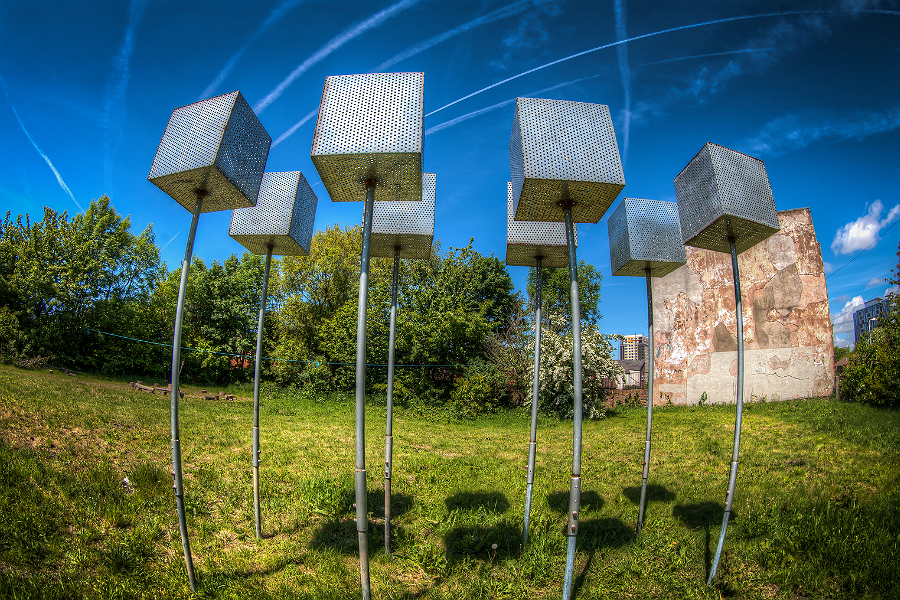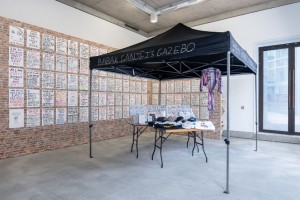The Silent Protester:
Jayne Lawless

When traditional forms of protest fail, where do you turn? Amy Jones speaks to Jayne Lawless about the scheme which pushed her toward arts activism…
For much of her career as a practicing artist Jayne Lawless has been searching for ‘home’. Born and raised in Everton, Liverpool, Lawless’ work has taken her all around the world; from the United States to Slovakia, many points beyond and back again.
“My work changed a lot in my time away from the UK. Giving me a fresh perspective on the themes of home, place and the poetics of space.” In 2008 the place she had always gone back to, her Mum and Dad’s house in Everton, was taken away. “It was only when we lost our house I realised how much I’d taken it for granted. Living in Cyprus at the time I didn’t get chance to see it before it was tinned-up. It was an unerving feeling to lose your anchor and the one steady place that’d always been there.”
The Housing Market Renewal Initiative (HMRI) was started by the Labour government as an effort to regenerate areas in which the housing market was seen to have collapsed; where houses where valued lower than the costs of building a new one. Their solution? The mass eviction and demolition of entire neighbourhoods to regenerate the area by building ‘better housing’, thus increasing property values.
What HMRI failed to take into account were the memories and the communities developed in these areas over generations, the time individuals and families had spent making a house into a home, and the value in these neighbourhoods that couldn’t be measured in pounds. Despite this, compulsory purchase orders were issued and people moved out leaving the Lawless’ family home empty along with hundreds of others.
There has since been a struggle to turn the spotlight on the situation in Everton and across the road in Anfield. There have been letters, there have been protests, but nothing seemed to draw people’s attention to the rows of tinned up houses lining the approach to Anfield Stadium. Lawless felt a different approach was needed: “We were getting nowhere with a loud protest, nobody was listening,” she says,“so I went the other way and created a ‘Silent Protest.’”

The Silent Protest to which Lawless refers is her sculpture L5 6QW. A unique-looking steel structure which until recently has stood on an idyllic hillside in South Wales, and before that on a hill in South Gloucestershire. The sculpture is made up of 8 steel boxes precariously balanced on 8 foot metal poles. On closer inspection you realise the material from which these boxes are welded is the very material used to tin up houses throughout the streets of Everton and Anfield.
The metal was given to Lawless after she contacted the company who tinned up the houses in her area. The process proved cathartic: “Making it into a sculpture, when it was merely seen as this horrible symbol of the end, was conveying the message that we can take this and we can reshape it. We have the possibility to do something else with this situation.”
Balanced precariously on 10 foot poles, the form of the sculpture is derived from the shape of the house in its most simple form. For Lawless this seemed an appropriate representation of the uncertainty she and her family faced while waiting for news about their home’s future. While the structure itself is intentionally simplistic, the process of making the boxes themselves was anything but.
Having not worked with galvanised steel, Lawless took it upon herself to construct eight large metal boxes. The building of the work was a hard and long process, taking more than seven months to complete: “everybody would come in and say ‘what box are you on now?’ and I’d say ‘three’…’what box you on now?’ ‘Five’ and when I got to five I thought, ‘what am I doing?,’ but I had to do it because that was my Silent Protest.”
The near impossibility of Jayne Lawless, an untried welder, shaping these sheets of galvanised steel, echoes the process of other works that were influential to Lawless when she was living in Somerset; Stonehenge and Avebury. The monumental quality was something Lawless wanted to recreate in the work, a monument to a battle that continues silently in the everyday lives of those affected by HMRI schemes.
The dialogue that has long surrounded Stonehenge and Avebury also attracted Lawless’ attention. She was keen to prompt viewers to engage in a wider conversation about Everton and Anfield through their experience with her work, encouraging them to feedback to a Facebook page. This has become an extension of the physical work and continues to document this diverse, at times inspirational, communication.
The work has just moved a little nearer to home in Bootle, L20, previous locations in South Gloucestershire and South Wales chosen based on a desire to further alienate the form and materials of the structure from Everton.
Despite the fact that it was situated in a quiet area with minimal footfall, Lawless felt this was an ideal home: “It wasn’t about it being in a public place, the metal’s in a public place now and still no-one cares. You’d have to tin up the town hall before people took notice.” By taking the work and its message out of context she heightened receptiveness to the issues.
The desire was always to bring L5 a little closer to home and back into the City, so when after two years in south Wales an opportunity arose to move the sculpture to Bootle’s Green Dream Project (for the next 12 months), Lawless was keen to explore the idea. She’d had suggestions to move the work into various parks around Liverpool and beyond, but never felt they were quite right. “It just doesn’t belong in a manicured park. It needs certain qualities to come together at the right time, it should be somewhere that’s grafted to get where it is or something that has also been abandoned.”
Bootle has been through similar ‘initiatives’ to Everton and Anfield and this site was used previously as an unofficial tip, complete with washing machines and old mattresses. However, Brian Dawe, who runs SAFE Productions, a project that promotes the idea that art can lead to well being, has now taken over the land as part of the Green Dream Project. The project has converted the site from urban wasteland to urban meadow with the L5 6QW sculpture at its heart. Here L5 will continue to tell its story, as well as becoming part of Bootle’s story too.
Activism through art has played a key role in the story of Everton and Anfield and HMRI. From the Liverpool Biennial commissioning Dutch artist Jeanne van Heeswijk to work with the community to explore the idea of ‘taking matters into your own hands’ with regard to housing, to Liverpool-based artists like Jayne Lawless.
Both projects are about enabling the residents to tell their own stories and to rebuild a community taken away by the destruction of their neighbourhood, thus hopefully, stimulating change: these projects not only represent growth and transformation in the area, but actively help to facilitate it. Art in this context engages the viewer to take part in a wider discourse around the HMRI crisis in Anfield and Everton, to become part of the story and contribute their own view.
As Lawless aptly states during our interview: “It’s not a five second story, it needs time. It’s too important, it means too much to too many people.” In a world were life-changing events are distilled into three minute news segments, Lawless’ work is not just about drawing attention to the situation in the area she grew up, but also about taking control of how the story is told and, importantly who gets to tell it.
Amy Jones
Images courtesy Peter Goodbody





